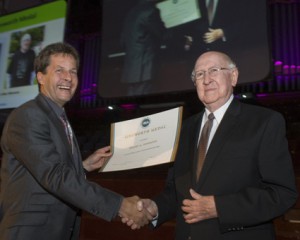
Steve Charles—Emory Simmons may be the most accomplished and esteemed scientist you’ve never heard of.
That’s partly my fault for not drawing the Wabash community’s attention to the fact that in the 10 years since we last wrote about him—between his 80th and 90th birthdays—he’s been honored numerous times (including being named “President for Life” of his professional organization) and published (at the age of 87) his signature work.
But it’s an almost inherent liability of his field of research: mycology. The study of fungi and molds. And Simmons’ own specialty—the characterization of microscopic fungi—is even more lost on the public.
Which seems strange when you realize that it was the study of molds that gave us antibiotics such as penicillin, cyclosporin and other pharmaceuticals, not to mention the production of beer, wine, and, cheese. Dr. Simmons’ particular specialty, the genus Alternaria, includes species that are plant pathogens and others that cause hay fever and asthma. Throw in the most recent fuss about molds contaminating homes and businesses, and you’d think we’d start paying attention.
“I used to be irritated, but now am amused, at the common reaction to my explanation of “mycology” as the study of fungi,” Emory told us back in 2001. “The range of response usually runs to finding spring morels and distinguishing between edible and poisonous mushrooms.
“In the real world, the estimate of fungus biomass is about two tons per human being in the overall biosphere. The unseen underground feeding mechanisms of fungi are the great recyclers: autumn leaves, cornstalk debris, mountains of trash, all returned to usable form mainly by fungi. No soil fungi, no trees and forests as we know them. No waving fields of grain. No escape from unforeseen pneumonia. No athlete’s foot. No bread, no booze. And on and on. Give us non-mushroom mycologists a break!”
Emory hasn’t taken many breaks. Even after his official retirement, he continues as a research associate of the College. For many years we never knew where he’d be next—leading workshops, assisting colleagues in various countries or working with collections around the world. We first covered his career after he received an honorary doctorate from the King of Thailand!
For his 90 birthday last spring he received a call from the president of the International Mycological Association (IMA) promising a surprise at the group’s quadrennial congress in Edinburgh, Scotland this year.
That surprise was the Ainsworth Medal for extraordinary service to international mycology, the highest honor a mycologist can receive and particularly rewarding as Emory was instrumental in founding the IMA. The photo here gives you some idea of the gravity of the event. The ovation began before the president could even finish reading the citation. You can read the nomination letter citing many of Dr. Simmons’ accomplishments here.
Two years ago he received the first-ever Johanna Westerdijk Award from the CBS Biodiversity Centre in the Netherlands for his outstanding contribution to the centre’s collection and distinguished career in mycology.
That award was in part in appreciation for the definitive volume on alternalia published in 2007— Alternaria: An Identification Manual—which took four years of 8-10 hour days for Simmons to complete and compiles much of his life’s work.
He claims to be slowing down a bit, although Emory has a strange way of showing it—a companion lab book for his alternalia volume may be in the works, and then there’s a “by invitation only” workshop he may be co-leading at Washington State…
When I asked him if he planned to continue his work, Emory said, “90 is just a number. Why not?”
For decades, a Wabash man has been one of the most esteemed and accomplished mycologists in the world. Also one of the most humble. Emory Simmons is averse to self-promotion of any sort, and the only way we found out about his work 10 years ago was because his friend Professor Emeritus Paul Mielke ’42 thought we ought to know.
It was his friend Professor Emeritus Dick Strawn who let us know about this latest award.
And now, finally, you do, too.